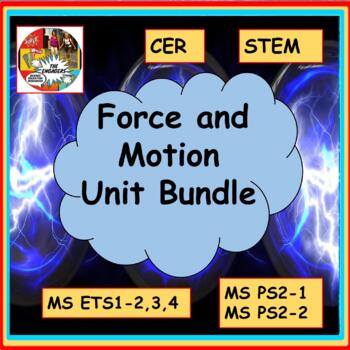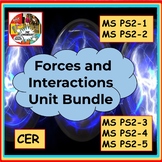Force and Motion Unit Bundle NGSS ALIGNED STEM CER
- Google Drive™ folder

Products in this Bundle (6)
showing 1-5 of 6 products
Also included in
- This bundle includes everything you need to teach an NGSS aligned middle school forces and interactions unit. These highly engaging lessons align with the philosophy of the NGSS, including a focus on deeper understanding of content as well as application of content, student performance expectations,Price $23.00Original Price $29.00Save $6.00
Description
This bundle includes everything you need to teach an NGSS aligned middle school force and motion unit. These highly engaging lessons align with the philosophy of the NGSS, including a focus on deeper understanding of content as well as application of content, student performance expectations, and integration with mathematics. The lessons are classroom tested and ready for immediate implementation.
This bundle supports the NGSS standards MS PS2-1, MS PS2-2, MS ETS1-2, MS ETS1-3, and MS ETS1-4.
INTRODUCTION TO MOTION VOCABULARY
These lessons (GOOGLE and PDF versions) start with an engaging activity to launch your force and motion unit. Key motion vocabulary that students will encounter during this unit is introduced. A separate file is also included which has 16 vocabulary slides to support the force and motion bundle. These can be used for classroom display to reinforce student understanding.
INVESTIGATIONS INTO BALANCED AND UNBALANCED FORCES
These engaging stations (GOOGLE and PDF versions) allow students to start to construct their own understanding of unbalanced and balanced forces including answers to the following questions:
What is a force?
What is the strength of the unit Newton?
How does a different force affect the same object?
How does the same force affect objects with different masses?
What is the difference between balanced and unbalanced forces?
How do you calculate the net force?
What causes objects to move?
Station 6 will require students to use the CER structure to write a conclusion.
Students will complete a summary statement worksheet after the stations are completed.
NEWTON'S FIRST LAW
Students are initially introduced to Newton’s First Law and how the force of friction is the unbalanced force that slows down objects (GOOGLE and PDF versions). A simulation is used to reinforce this concept and an investigation into friction is included. This friction investigation will require students to use the CER structure to write a conclusion.
Five engaging stations then allow students to build their understanding of Newton’s First Law. If necessary these stations can be completed at home. Students complete a summary statement worksheet after the stations are completed and discussed.
NEWTON'S SECOND LAW
These investigations (GOOGLE and PDF versions) allow students to develop an understanding of the relationship between mass, sum of the forces, and change of motion. As students are performing the investigations, the equation for Newton’s second law, when introduced, will be easily understandable.
Instructions are given for both in class investigations and online investigations.
Students will be designing and performing their experiments, collecting data, and analyzing the data to see the relationship between mass, forces, and change in motion.
They will use the CER (claim, evidence, reasoning) structure to write their conclusions.
Next they apply their knowledge of Newton’s second law to three new situations. This can be used as a formative assessment of student understanding.
NEWTON'S THIRD LAW
Students move through five stations that guide them to “discover” Newton’s third law (GOOGLE and PDF versions). Students then complete a summary worksheet where they identify the action and reaction involved for each station. Next they apply their knowledge of Newton’s third law to three new situations. This can be used as a formative assessment of student understanding.
CONSTRUCTING A SPACE STATION THAT WITHSTANDS A COLLISON
This highly engaging lesson is a design solution to a problem involving two colliding objects (standard MS PS2-1).This engineering and design project (GOOGLE and PDF versions) allows students to gain a greater understanding of why we need to build space stations that can withstand collisions.
The students first learn about crumple zones and why they are helpful in a collision.
Students design, construct, and test three crumple zones (made of simple materials) to see which is the best for attachment to their space station. Students then design, construct, and test their space station (made of simple materials) to see if it will withstand a collision with a “baseball” meteoroid.
A written formative assessment is included which allows for students to critique their design and offer ideas for improvements. It also allows students the opportunity to connect this collision with Newton’s third law.
The science and engineering practices below are incorporated in this unit:
Developing and using models.
Engaging in argument from evidence.
Planning and carrying out investigations.
Analyzing and interpreting data.
Constructing explanations and designing solutions.
The students will encounter the Cross-cutting concepts
Stability and Change
Systems and system models
Easily obtainable materials are used for these lessons.
Teacher slides (134 slides)
Detailed teacher notes including all materials needed (54 pages)
Printable student worksheets with activity instructions, analysis questions, and formative assessment (35 pages)
Sample answers for student worksheets
Don't forget to give a review for this resource to earn TPT credits towards future purchases!
You may also like:
A unit on gravitational forces MS PS2-4 CER
Kinetic energy, mass, and speed investigations NGSS MS PS3-1 CER
Investigating Potential Energy and Energy Transfer NGSS MS PS3-2 CER
Investigating magnetic forces NGSS MS-PS2-3 MS-PS2-5 CER
Also, FOLLOW US to be notified when new products are added!
Email any questions you have with the subject line “Force and Motion Unit Bundle” to us at engagersinscience@gmail.com and we’ll be happy to answer them.
Other teaching resources for sale in our Teachers Pay Teachers store can be accessed by using the link below:
Click here to access our products






